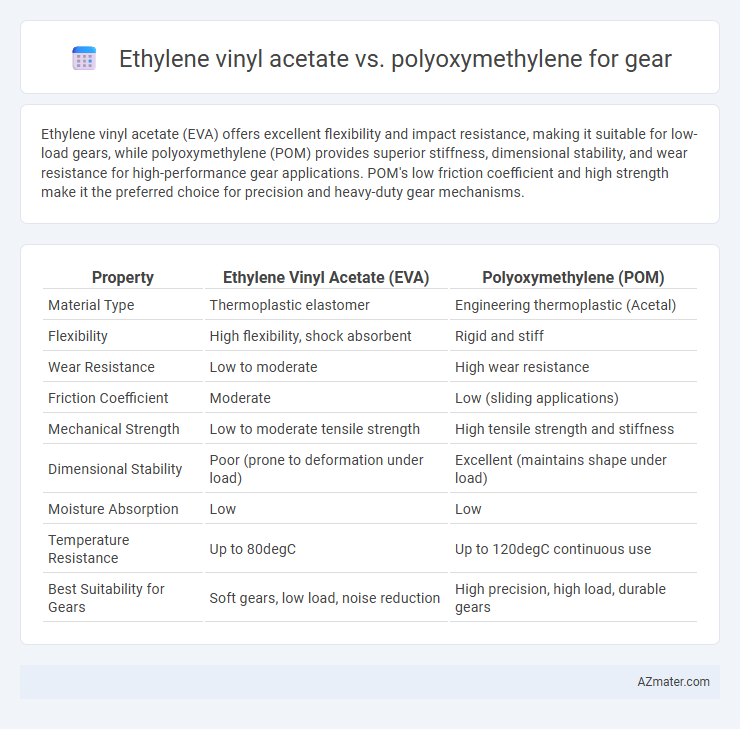Ethylene vinyl acetate (EVA) offers excellent flexibility and impact resistance, making it suitable for low-load gears, while polyoxymethylene (POM) provides superior stiffness, dimensional stability, and wear resistance for high-performance gear applications. POM's low friction coefficient and high strength make it the preferred choice for precision and heavy-duty gear mechanisms.
Table of Comparison
| Property | Ethylene Vinyl Acetate (EVA) | Polyoxymethylene (POM) |
|---|---|---|
| Material Type | Thermoplastic elastomer | Engineering thermoplastic (Acetal) |
| Flexibility | High flexibility, shock absorbent | Rigid and stiff |
| Wear Resistance | Low to moderate | High wear resistance |
| Friction Coefficient | Moderate | Low (sliding applications) |
| Mechanical Strength | Low to moderate tensile strength | High tensile strength and stiffness |
| Dimensional Stability | Poor (prone to deformation under load) | Excellent (maintains shape under load) |
| Moisture Absorption | Low | Low |
| Temperature Resistance | Up to 80degC | Up to 120degC continuous use |
| Best Suitability for Gears | Soft gears, low load, noise reduction | High precision, high load, durable gears |
Introduction to Gear Materials
Ethylene vinyl acetate (EVA) and polyoxymethylene (POM) are widely used materials in gear manufacturing, each offering distinct mechanical and chemical properties. POM, known for its high stiffness, low friction, and excellent dimensional stability, is preferred for precision gears requiring durability and wear resistance. EVA provides superior flexibility and impact resistance, making it suitable for gears subjected to shock loads and requiring noise reduction.
Overview of Ethylene Vinyl Acetate (EVA)
Ethylene vinyl acetate (EVA) is a flexible, semi-rigid copolymer known for its excellent impact resistance, low-temperature toughness, and good adhesion properties, making it suitable for gear applications requiring cushioning and noise damping. Its chemical resistance to oils, UV radiation, and stress cracking enhances durability in dynamic environments. EVA's lower stiffness compared to polyoxymethylene (POM) limits its use in high-load gears but offers superior flexibility and vibration absorption.
Overview of Polyoxymethylene (POM)
Polyoxymethylene (POM), also known as acetal, is a highly crystalline engineering thermoplastic renowned for its exceptional hardness, low friction, and excellent dimensional stability, making it ideal for precision gears. Its superior wear resistance and chemical resistance outperform Ethylene Vinyl Acetate (EVA), which typically offers greater flexibility but lower mechanical strength and thermal resistance. POM's ability to maintain performance under high load and cycling conditions ensures reliable gear operation in automotive, industrial, and consumer applications.
Mechanical Properties: EVA vs POM
Ethylene vinyl acetate (EVA) exhibits excellent flexibility and impact resistance but lower tensile strength and hardness compared to polyoxymethylene (POM), which offers superior stiffness, dimensional stability, and wear resistance crucial for gear applications. POM's high modulus of elasticity and low friction coefficient ensure efficient load transfer and reduced operational noise in precision gears. EVA's mechanical properties suit low-load, flexible gear components, whereas POM predominates in high-performance, durable gear mechanisms demanding long-term reliability.
Wear Resistance and Durability Comparison
Ethylene vinyl acetate (EVA) offers moderate wear resistance and flexibility suitable for light-load gears, while polyoxymethylene (POM) demonstrates superior wear resistance and dimensional stability under high-load conditions, enhancing gear durability. POM's low coefficient of friction and excellent fatigue resistance contribute to longer gear lifespan, making it ideal for precision and high-stress mechanical applications. EVA gears may underperform in abrasive environments, whereas POM maintains structural integrity and wear resistance, extending maintenance intervals and operational reliability.
Noise and Vibration Performance
Ethylene vinyl acetate (EVA) offers superior noise and vibration damping in gear applications due to its flexible and elastic polymeric structure, effectively reducing operational sound and minimizing vibration transmission. Polyoxymethylene (POM), known for its high stiffness and low friction coefficient, provides excellent dimensional stability and wear resistance but transmits higher noise and vibration levels compared to EVA. Selecting EVA results in quieter and smoother gear operation, whereas POM favors precision and mechanical strength, requiring additional noise reduction measures in sensitive environments.
Chemical and Environmental Resistance
Ethylene vinyl acetate (EVA) exhibits excellent chemical resistance to acids, bases, and alcohols, making it suitable for gears exposed to various corrosive environments, while its flexibility and impact resistance enhance durability. Polyoxymethylene (POM), also known as acetal, offers superior resistance to solvents, hydrocarbons, and organic chemicals, along with exceptional wear resistance and dimensional stability under mechanical stress. In terms of environmental resistance, EVA performs well against UV radiation and moisture, whereas POM has limited UV resistance but maintains performance in low-temperature and high-humidity conditions.
Machinability and Processing Differences
Ethylene vinyl acetate (EVA) offers superior flexibility and impact resistance for gear applications, but its machinability is limited due to its softer, more rubber-like texture, requiring slower cutting speeds and specific tooling to avoid deformation. Polyoxymethylene (POM), also known as acetal, exhibits excellent machinability with high dimensional stability and low friction, enabling precise, clean cuts ideal for high-performance gears. Processing EVA involves lower melting temperatures and extrusion methods, while POM demands higher processing temperatures and controlled cooling to prevent warping and maintain mechanical integrity.
Cost and Availability Factors
Ethylene vinyl acetate (EVA) offers lower raw material and processing costs compared to polyoxymethylene (POM), making it a more budget-friendly option for gear production. EVA's wide availability and ease of processing contribute to consistent supply chains, whereas POM, despite its superior mechanical properties, tends to be more expensive and less readily available, especially in high-performance grades. Cost-efficiency and material availability are critical factors driving the choice of EVA for applications where moderate strength and flexibility suffice over POM's rigidity and durability.
Application Suitability: Choosing the Right Material for Gears
Ethylene vinyl acetate (EVA) offers excellent flexibility and impact resistance, making it suitable for low-load, noise-reducing gear applications in consumer products. Polyoxymethylene (POM), also known as acetal, provides superior stiffness, low friction, and high wear resistance, ideal for high-performance gears in automotive and industrial machinery. Selecting between EVA and POM depends on the gear's operational demands, with POM favored for precision and durability, while EVA suits environments requiring shock absorption and noise dampening.

Infographic: Ethylene vinyl acetate vs Polyoxymethylene for Gear
 azmater.com
azmater.com